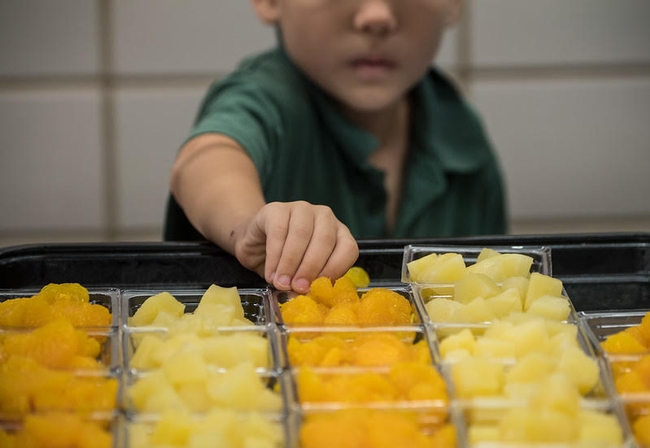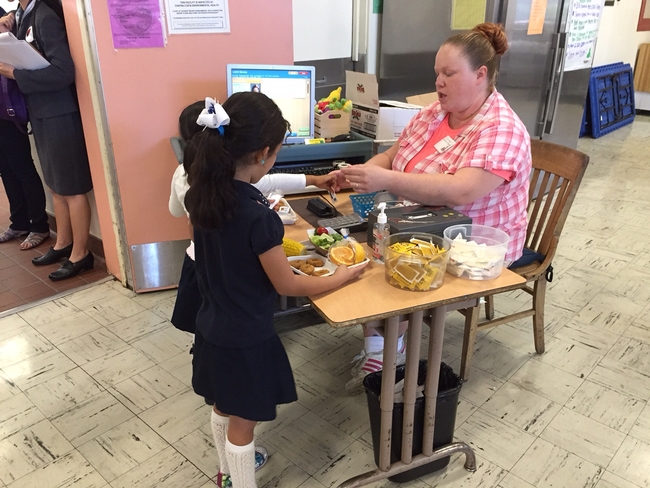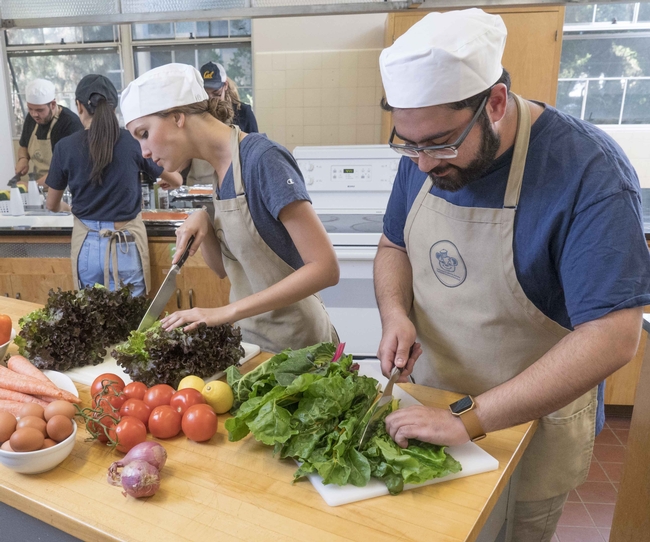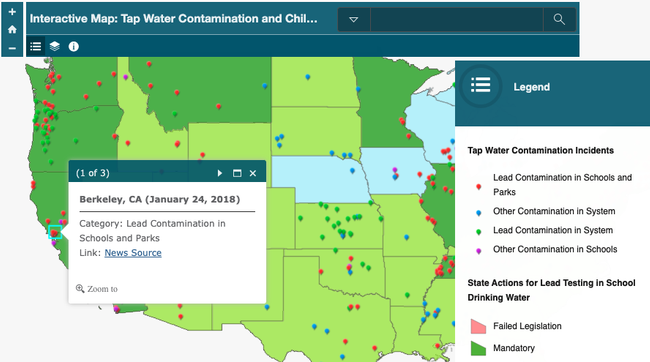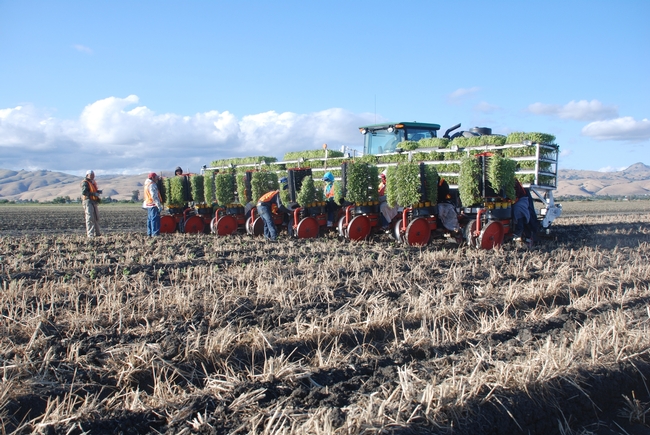Posts Tagged: Nutrition Policy Institute
Universal school meals increased student participation, lessened stigma
The COVID-19 pandemic exacerbated food and nutrition challenges. Many families initially lost access to meals offered by school and childcare facilities, experienced unemployment or work reductions, and faced increasing prices for food and other necessities. National and state policies and programs provided food and cash assistance to mitigate impacts on food security. Researchers at the Nutrition Policy Institute, a research center of University of California Agriculture and Natural Resources, evaluated safety-net policies implemented during the pandemic to better support families with low incomes in the U.S.
Benefits of universal school meals
The National School Lunch Program and the School Breakfast Program meet the nutritional needs of approximately 30 million K-12 students in America each day. Typically, students from families meeting income eligibility criteria receive school meals for free or a reduced price, while others pay full price.
NPI researchers Wendi Gosliner, project scientist, and Lorrene Ritchie, director and UC Cooperative Extension specialist, are co-leading studies of school meals in California in collaboration with researchers from the NOURISH Lab for Health Inclusion Research and Practice, who study school meals in Maine and other states.
During the COVID-19 pandemic, Congress funded school meals for all students at no charge, in order to address the dramatic increase in food insecurity among families with children after schools shut down in March 2020. This federal provision allowing for meals to be free for all students ended after the 2021-2022 school year, but some states elected to continue providing universal school meals with state funding, in recognition of the importance of these meals for student health and academic success.
California was the first state to adopt a statewide Universal Meals Program starting in the 2022-23 school year. To support the program's development, $650 million were invested to help schools improve kitchen infrastructure and provide staff training and technical assistance. Investments include Farm to School programs and other mechanisms to help update and improve school meals. Maine and several other states also have adopted universal school meals at least through the 2022-23 school year.
“States often act as incubators – things that work well in states sometimes get translated into federal policy,” Gosliner said. Identifying the success of the programs – and their challenges – can lead to improvements and help inform advocates and policymakers considering universal school meals policies at the state and national level.
Two of the team's research studies in California and Maine documented the benefits and challenges of universal school meals, as reported by school food authorities. Among 581 school food-service leaders in California who responded to the survey, nearly half (45.7%) reported reductions in student stigma as a result of providing free school meals to all students. Among 43 respondents in Maine, over half (51%) reported lessened stigma related to school meals being free for all. In both studies, nearly three-quarters of respondents reported increases in student meal participation. These and other data suggest that universal school meals are meeting their aim, to increase student participation while providing nutritionally balanced meals.
But when the child leaves campus, the responsibility to put a nutritious meal on the table falls on the caregiver.
“Universal school meals provide food and can ease families' budgets, but for too many families, wages as well as time and other resources are not adequate for access to and consumption of enough healthy foods and beverages,” Gosliner noted.
That is when other public programs are helpful, for example the Earned Income Tax Credit, or EITC.
Many eligible families do not claim Earned Income Tax Credit
The Earned Income Tax Credit is a national program designed to lift families out of poverty. The supplemental income can contribute up to nearly $7,000 per year for a family. Despite the EITC's known ability to improve participants' health, research shows that many EITC-eligible households in California and across the nation don't receive the benefits for which they are eligible, leaving $2 billion unclaimed in California in 2018 alone.
Gosliner led a study along with Lia Fernald from UC Berkeley and Rita Hamad from UC San Francisco to document levels of awareness, barriers to uptake, and benefits of participation in the EITC. Their recent publication reported that among 411 EITC-eligible California female caregivers, those who were younger, spoke languages other than English, and had less awareness of the EITC were less likely to receive the tax credit.
Developing a user-friendly system for providing safety-net support and, in the meantime, providing information and support to help more EITC-eligible families receive these benefits are suggested to help alleviate financial stressors. In the long term, these strategies may reduce poverty and improve the health of children.
Increasing WIC Cash Value Benefit a boon to health
In addition to universal school meals and EITC, families with low income may be eligible for the Special Supplemental Nutrition Assistance Program for Women, Infants and Children, or WIC. The program supports women and children up to 5 years old through nutrition education, nutritious foods and access to other health and social services.
One component of the WIC food packages, the Cash Value Benefit, provides participants a fixed dollar amount to supplement their family's diet with fruits and vegetables. During the pandemic, the U.S. Department of Agriculture increased this benefit from $9 to $35 per month, which was later revised to $24 per month per child in October 2021.
Ritchie contributed to a growing body of evidence on the importance and multidimensional benefits of the WIC Cash Value Benefit increase.
“Nine dollars buys only a quarter of what a child is recommended to eat every day,” Ritchie said. “The increase in Cash Value Benefit during the pandemic was an ideal natural experiment to investigate its impact.”
In collaboration with Shannon Whaley and her team at the Public Health Foundation Enterprises-WIC, NPI launched a longitudinal cohort study of nearly 2,000 California WIC participants. They found that the increased Cash Value Benefit improved WIC participant satisfaction with the program and allowed families to purchase greater quantities and varieties of fruits and vegetables.
“The increased Cash Value Benefit enabled WIC families to expose young children to new fruits and vegetables. Early exposure to a variety of fruits and vegetables is critical to establishing lifelong healthy habits,” said Ritchie.
The researchers found that the benefit increase also reduced food insecurity. It is hoped that the increase in program satisfaction translates into more eligible families enrolling and continuing to receive WIC. In November 2022, the U.S. Department of Agriculture proposed making the increased Cash Value Benefit a permanent part of WIC.
Knowing the proven benefits of the WIC program, Ritchie and colleagues from the National WIC Association, and Loan Kim at Pepperdine University, also engaged with WIC participants in other states.
In 2021, all state WIC agencies were invited to participate in a WIC satisfaction survey. Of the 12 WIC state agencies that opted to participate, Connecticut, Inter Tribal Council of Arizona, Nevada, New Hampshire and New Mexico added questions on the survey to understand how the increased Cash Value Benefit impacted children's dietary intake.
The study showed consumption of fruits and vegetables by children on WIC increased by one-third cup per day on average, which is sizable when considering the impact across the WIC population.
NPI research on universal school meals, the EITC and WIC constitute a small part of a more comprehensive approach to make healthy food more accessible, affordable, equitable and sustainable for all. The NPI provides resources such as policy briefs, peer-reviewed publications and technical assistance on several research areas such as safe drinking water, childcare and education. To learn more, please visit the Nutrition Policy Institute website.
Teaching Kitchen course helps improve college students’ food security
Cooperative Extension researcher: Nutrition course a boon for UC Berkeley students
College students across the nation are struggling to meet their basic food needs. Within the University of California system of 280,000 students, 38% of undergraduate students and 20% of graduate students report food insecurity.
As part of the UC Global Food Initiative, in 2015 the Nutrition Policy Institute (a UC Agriculture and Natural Resources statewide research center) identified student food insecurity as a UC systemwide problem, prompting the UC Regents and campuses to collectively address the issue.
All 10 UC campuses now have on-site basic needs centers, providing food, emergency housing and support services. The UC system and campus working groups recognize that meeting basic needs, such as food, is a multidimensional challenge.
In response to the 2022 White House Conference on Hunger, Nutrition, and Health, which called for national efforts to reduce diet-related disease and food insecurity, UC renewed their commitment to cut the proportion of students facing food insecurity in half by 2030. Campuses will partner with local counties to maximize enrollment in the Supplemental Nutrition Assistance Program (also known as CalFresh in California), provide food for students who do not qualify for CalFresh, and allocate campus food resources to historically underserved student populations.
NPI's collaborative researchers continue to monitor the impact of these efforts, in addition to other interventions, such as supporting students in building basic culinary skills, to improve food security. One multipronged approach to address food insecurity at UC Berkeley is a 14-week course on Personal Food Security and Wellness with a Teaching Kitchen laboratory component.
Sarah Minkow, who teaches the Personal Food Security and Wellness course at UC Berkeley, shared that students learn about nutrition and gain culinary skills through the Cal Teaching Kitchen.
The curriculum is designed with consideration for the time, cost and convenience of healthy eating. Discussions include food safety, calculating nutrient needs, mindful eating and reading nutrition labels. The Teaching Kitchen laboratory brings the lessons to life through knife skills, “no-cook” cooking, microwave cooking and sheet pan meals.
Minkow enthusiastically highlighted her students' “overwhelmingly positive [response to the] lecture and lab,” suggesting the benefits of an interactive learning environment to garner student engagement.
“Students often give feedback that they wish this was a required course for all UC Berkeley students,” said Minkow. She noted one barrier to reaching more students: capacity of the Teaching Kitchen space.
Susana Matias, a Cooperative Extension specialist at the UC Berkeley Department of Nutritional Sciences and Toxicology and collaborative researcher with the NPI, evaluated the impact of the Personal Food Security and Wellness course at UC Berkeley.
Matias reported that increasing food literacy and culinary skills among students has shown to increase intake of fruits and vegetables, and frequency of cooking, and reduce the number of skipped meals. Her study on the impact of the 14-week nutrition course also found a significant decrease in student food insecurity.
Across the UC System, students are benefiting from their campus Teaching Kitchens, including UC Berkeley, UC Davis, UCLA and UC Riverside. Other campuses such as UC San Diego, UC San Francisco, UC Santa Cruz and UC Santa Barbara offer basic student cooking classes as well.
Katherine Lanca, UC Global Food Initiative fellow working with NPI, attended the 2022 Teaching Kitchen Research Conference as part of her fellowship to learn about the latest research on teaching kitchens supporting equitable health outcomes.
The conference was hosted at UCLA by Harvard T.H. Chan School of Public Health Department of Nutrition in association with the Teaching Kitchen Collaborative. Teaching kitchens are a promising approach to supporting food security and cultivating lifelong habits, especially among a college student population.
Study: Government shutdown stressed food assistance program participants
A U.S. federal government shutdown can represent a minor inconvenience, a delay in paychecks, or – for people living in some of the most difficult circumstances – an extended period of hunger and anxiety.
A study published recently in the journal Nutrients provides a unique glimpse into the shutdown experiences of participants in CalFresh – California's name for the federally funded Supplemental Nutrition Assistance Program (formerly known as food stamps). Currently, about 42 million people participate in SNAP across the U.S.
In focus groups conducted in 2019 with 26 low-income CalFresh participants from four diverse California counties, participants shared how the 2018-19 federal government shutdown affected their SNAP benefits, their perception of the program and their faith in government.
One of the immediate effects of the 2018-19 shutdown was that February CalFresh benefits were distributed in January. And while that meant program participants saw extra benefits that month, they then had to wait 40 to 44 days until the March issuance – much longer than the usual 28 to 31 day cycle.
“What we saw with this study is that this extended lag in benefit receipt from January to March was devastating,” said Wendi Gosliner, senior researcher and policy advisor at the Nutrition Policy Institute of UC Agriculture and Natural Resources, and an author of the study funded by UC ANR.
She recalled one participant who, despite having a gastrointestinal issue that requires a special diet, had to eat canned food from the food bank that made her sick – rather than go hungry while waiting for her March benefits. Others described cascading financial challenges after using rent money for food in February, or going into debt to pay for food and getting behind on other expenses.
The study also chronicles the experiences of a woman who was anguished to hear the suffering of her daughter, also a CalFresh participant: “She called me several times crying, ‘Ma, I don't – we don't have enough food. What am I going to do…? You know, I can't afford to this and this and this.' And I can't help her.”
For individuals grappling with food insecurity, the stress of feeding their families was compounded by the uncertainties of the government shutdown. And while many participants exercised their agency and resourcefulness in coping with the situation, they also felt a degree of powerlessness amid the “confusion and craziness,” as one person put it.
“No one knew how long that shutdown was going to last; no one knew if the March benefits were going to be paid,” Gosliner said. “And as we learned, there were all kinds of stories circulating out there about what was going on with the uncertainty – a lot of people didn't have the information about what was actually happening.”
Some participants, seeing the “double benefit” in January 2019, thought that it was the last-ever distribution and that SNAP was ending. Others described being unable to get in touch with the CalFresh agency to get their questions answered about the benefits. Most participants had not heard about the disrupted benefit schedule before receiving the benefits. As a result, many people in the focus groups shared that their overall faith in government had been shaken.
Improving customer service, boosting benefit levels and adjusting eligibility and benefit formulas to reflect high cost-of-living and expenses related to working were three recommendations that came from the focus group participants.
A fourth recommendation tackles the shutdown issue head-on: Don't let it happen again.
“Congress should do absolutely everything in their power to be sure that the program operates on the usual time schedule – even if the government is shut down,” Gosliner said.
In the context of the global pandemic, when financial and social inequities and physical and mental health disparities have been laid bare, ensuring access to healthful food is even more important. And with studies showing that hospitalizations increase with longer lags between SNAP distributions, Gosliner said the “absolute last thing” the overburdened health system needs is more people in emergency departments seeking acute care.
“It's the worst time to be having people who need money to feed their families face additional insecurity,” she said. “It's critically important that Congress acts to be sure that there is not any disruption in benefits.”
The authors of the study, “Participants' Experiences of the 2018–2019 Government Shutdown and Subsequent Supplemental Nutrition Assistance Program (SNAP) Benefit Disruption Can Inform Future Policy,” are Wendi Gosliner, Wei-Ting Chen, Cathryn Johnson, Elsa Michelle Esparza, Natalie Price, Ken Hecht and Lorrene Ritchie.
The study can be found online at https://www.ncbi.nlm.nih.gov/pmc/articles/PMC7353319.
Interactive map flags locations of tap water contamination
Drinking water safety, especially for children, has become an issue of heightened concern since the water crisis in Flint, Michigan, in 2014.
The National Drinking Water Alliance map has recently been updated to add over 235 new points linking to news reports of tap water contamination, with nearly half of the incidents emerging since 2019.
“We created the map to help community members, advocates and decision-makers visualize the tap water contamination landscape, particularly for incidents of lead that exceed state action levels,” said Christina Hecht, UC Nutrition Policy Institute senior policy advisor and National Drinking Water Alliance coordinator.
Residents can zoom in on their state to check for contamination incidents that were reported in the news. Red pins indicate lead contamination in schools and parks. Clicking on a pin on the map produces a pop-up box containing the name of the town, date and link to the news story.
“Although most tap water is safe for drinking, the number of dots on the map show that there are times and places where tap water is not safe,” Hecht said. “The only way to know if tap water has elevated lead is by testing through an accredited lab.”
The interactive map was created by the Nutrition Policy Institute and Informatics and Geographic Information System at the University of California Agriculture and Natural Resources. The map only includes tap water contamination with lead and contaminants regulated by the U.S. Environmental Protection Agency. For example, reports of perfluoroalkyl substances, or PFAS, contaminating drinking water are not included because PFAS are not regulated by the EPA.
Although a few states now maintain some type of online database of results from school or childcare tests for lead in tap water, to date, there is no national database of lead exceedances in school or childcare drinking water.
The National Drinking Water Alliance map includes information on state policies and programs to test for lead in school drinking water. Almost one-third of U.S. states have enacted legislation providing policy to test for lead in drinking water in schools and, in some cases, in child-care centers. California tests for lead in drinking water at all public K-12 schools and posts the results online. Policies for mandatory testing have recently passed in Oregon and Vermont. New legislation has been proposed in Wisconsin, Iowa, Nebraska and Connecticut. Voluntary programs are now present in every state, funded by nationwide federal grants supporting testing in child-care facilities and schools.
More information on each state's actions can be found on the interactive map at www.drinkingwateralliance.org/new-map, which was updated by Nutrition Policy Institute intern Laurel Denyer, a recent UC Davis graduate.
For more information about drinking water safety, and to propose additions to the map, please contact the NDWA at DWAalliance@ucanr.edu.
Fighting hunger and building planet health go hand in hand
University leaders, faculty and students from across the U.S. and around the world are working together to tackle a complex set of challenges that prevent millions of people from getting enough of the right foods. In March 2021, UC Davis, the UC Global Food Initiative and the UC Agriculture and Natural Resources Nutrition Policy Institute, in partnership with the Hunger Solutions Institute at Auburn University, hosted a summit for members of Universities Fighting World Hunger, where more than 500 attendees from 22 countries sought solutions to the tragedy of world hunger, food insecurity and malnutrition that results in chronic diseases and obesity.
The 16th annual summit, held virtually for the second time, introduced a new way to address hunger by focusing on its connections to global climate change and the catastrophic COVID-19 pandemic.
Opening keynote speaker Bill Dietz, director of the Redstone Global Center for Prevention and Wellness at George Washington University, called the multiple threats to human well-being a “syndemic” driven by political power, capitalism, social norms and structural racism.
He suggested triple-duty solutions to the syndemic. For example, for U.S. populations, increasing plant-based foods and reducing beef consumption leads to (1) healthier diets that reduce obesity, diabetes and cancer; (2) improves nutritional quality and food security; and (3) lowers greenhouse gas emissions from agriculture and cattle production.
“I don't mean to say we eliminate beef,” Dietz said. “Beef can be healthy if grass fed and contains micronutrients. We need to reduce it. I don't pretend that's an easy lift. There is resistance at the highest levels of government. But we need to generate the political will to turn that around.”
Dietz recommended the development of local and regional food systems for food resilience, health, equity and environmental sustainability. Regional systems are more agile and not devoted to monoculture, such as that found in the U.S. Midwest where great swaths of land are managed exclusively for corn production.
“The question is not what we need to do, but how to do it,” Dietz said. “We need to act now. We need to build political will. We need to hold leaders accountable.”
A new Green Revolution
On the world stage, increasing access to food must address poverty, inequality, wars and politics, said Rattan Lal, distinguished professor of soil science at Ohio State University.
The projections that the earth will have 2 billion more residents by 2050 means there's a need for a new “Green Revolution,” Lal said. In the 1950s, fears that food production was lagging behind population growth were rampant. The fears were not realized due to the mid-century Green Revolution, in which research and technology boosted agricultural production worldwide with advances in variety selection, irrigation, synthetic fertilizers and pesticides. Yields rose exponentially.
“This miracle saved hundreds of millions from starvation,” Lal said. “Despite all that progress, there is still hunger.”
To meet food demand anticipated in 2050, the new Green Revolution must be different.
“Rather than input based, it must be natural resources based,” Lal said. “The strategy is to produce more food from less land, less water, less fertilizers and less energy.”
Managing agricultural land with regenerative principles – such as maintaining year-round soil cover, eliminating tillage and applying integrated nutrient management – leads to healthy, sustainable and productive soils that lock up carbon and minimize greenhouse gas emissions to the atmosphere.
“Something I hope to see protected in the new Farm Bill – the rights of soil,” Lal said. “Soil is a living entity. It has rights. We have a Clean Air Act, a Clean Water Act. It is time for a Healthy Soil Act. I hope it will be in 2022 or 2023. That involves policy translating science to action.”
The benefits of soil health are research-proven, but not yet widely implemented on farmland around the world, an example of a dichotomy shared by summit keynote speaker Jeffrey Sachs, an economist with the Center for Sustainable Development. He quoted the well-known observation of science fiction writer William Gibson, “The future is already here – it's just not evenly distributed.”
“There are solutions. I call them pathways. They are not gimmicks,” Sachs said. “Our work is to build the public understanding and awareness of the importance of these pathways.”
Sachs encouraged summit attendees to advocate locally and at the state and federal levels to promote new food systems approaches.
“Write blogs, op-eds and suggestions. What can corporations commit to? What should governments commit to? What can the food industry commit to?” Sachs said. “A lot of agricultural policies promoted by large commercial interests neglect environmental objectives. What we need is a one-world approach to move beyond the narrow view of a powerful corporate lobby and move to ecosystem sustainability in agriculture, carbon storage, healthful diets and a culture of appreciation of agriculture and healthful food.”
A role for land grant universities
Lorrene Ritchie, director of UC's Nutrition Policy Institute, said she believes UC Agriculture and Natural Resources and other land grant institutions can help direct humanity along a pathway of human and planet health.
“We have nutrition programs, dairy and beef research, irrigation, pest control, production, and natural resources expertise, and are well positioned to work together,” Ritchie said. “As a nutrition researcher, I can bring expertise on human dietary needs, while others can identify the crops that are most environmentally sustainable in different ecosystems. How we can get the best nutrition with the smallest environmental impact is the key question to address.”
Consumers can also help protect the planet's health with information to make educated decisions about their food choices.
“I would like to see food labeling not only for nutrition, but also on the product's sustainability,” she said.
Impacts from food on the planet's health involve production, water use, transportation, packaging and other factors.
“It kind of makes you dizzy to think about balancing impacts to human health and planet health. At UC ANR, we have the expertise and we can contribute to making progress in California and beyond in that regard. Complex problems will require multiple solutions – the time to act is now,” Ritchie said.


